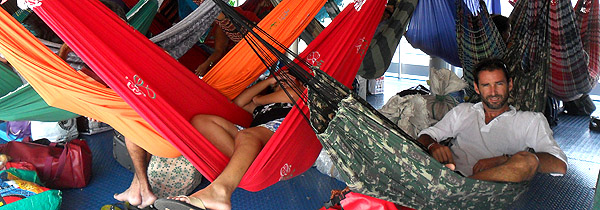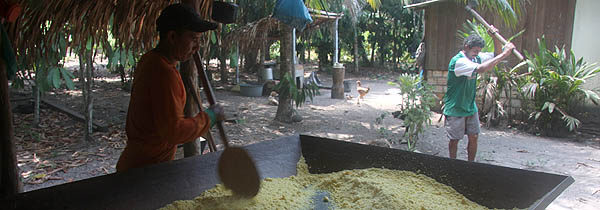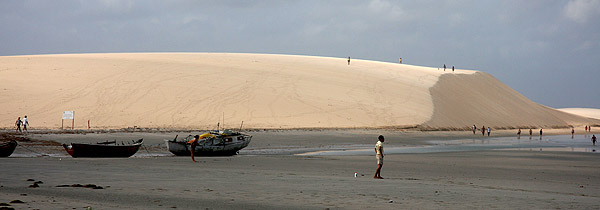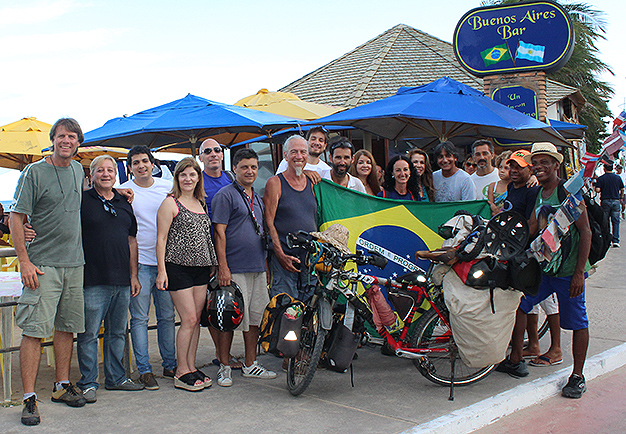 Brazil – Km 143.010
Brazil – Km 143.010
From Peru, I entered Brazil through the Amazon River. Tabatinga is the Brazilian city that shares a border with Leticia, Colombia and Santa Rosa, Peru. The area is known as the triple border, a hot region marked by violence and drug traffic. Under a strict control of the Brazilian federal police I board to the city of Manaus. These ships sailing the Amazon River for days, usually carry 200 to 300 passengers; in them there are no seats and there are hardly any 3 or 4 cabins at an expensive price for travelers. Therefore, it is almost a must to carry a hammock, unless you want to travel sitting on the floor. Simply find a place to hang it. What is surprising is when the boat seems to be full and it still people boarding and hanging its hammock just 5 cm close to you, or in the worst case, just over you, as I experienced on another trip. And as in this type of boat there are not many rules, that time, my options were moving my hammock to another place or put up the journey of several days with my neighbor’s ass, practically in my face. So I chose the first.

At first sleep in a hammock can be uncomfortable, if only comes to find the diagonal position; and when you get used to, it can be more relaxing than sleep in a bed, because being hanged there is no point of pression at any part of your body and relaxation is total. During my tour of northeastern Brazil,if I had the choice between a bed and a hammock, I chose the second.
Brazilian boats are a luxury, next to the Peruvian ships, because they are clean, the food is much better, in quantity and quality and safer. In the two ships I boarded in Peru, I was warned to take care of my luggage, because during overnight stops, they often steal, while you are sleeping,
When I arrived in Manaus I settled at Wesleys appartment , who I contacted online. This good guy was not even at home, and although he did not know me, through his cousin he left me the key and his appartment available, as if we knew a lifetime. For a few days I stayed in the Amazon capital that has a population of over 2 million inhabitants, which is not friendly for cyclists, because its streets have neither a minimum pedaling space,it seem a racetrack; a feature of Brazilian cities, the land of beloved Ayrton Senna. But the hardest thing in Manaus is that moisture reaches 90%. In this city, fast-paced, you sweat as if you are in a sauna. Nor on the beach of Ponta Negra, the largest resort city, I felt comfortable, the heat is stifling.
The next stop after 2 days of boat was Santarem, located at the confluence of the Amazon River with the Tapajos River, this one known for its crystal clear waters. Just 30 km away from the city is Alter do Chao a hidden paradise; a fishing village with beautiful beaches of fine white sand, which are formed during dry season when the Tapajos river is low.

From there, about 50 km of dirt road is the Tapajos Reserve, an area inhabited by traditional indians whose survival is based on agriculture, hunting and fishing. After another 50 km, where I had to drag the bicycle as a mule, I arrived to Piquiatuba, where I settled for a few days to explore the region. Zezinho, the head of the community, enabled me the guest house to hang my hammock. This guest house is a project to receive tourists someday. As Zezinho explained to me, in the reserve there are more than 20 communities that host between 1000 and 1200 families that aim to protect their culture and way of life, ensuring the sustainable use of natural resources. That way I witnessed the collection of cassava and process for preparing the farofa, the traditional accompaniment and typical of Brazilian cuisine, many families tend to produce in larger quantities for sale. I also went canoeing and net fishing; and I was feted with quirquincho grilled and pan, which was a delight. During those days, Zezinho showed me how little is needed to live with dignity when nature is generous.

From the province of Pará my tour of northeastern Brazil continued to Maceio, almost always windy along the coast and therefore knee pain. But the greatest difficulty found when looking for a place to sleep. On several occasions I asked permission to camp, and I was rejected. People are afraid and do not seem to me so hospital and cheerful as in the year 99 when I returned from Maceio to Argentina by bicycle.
Although the political instability of the government for the corruption and the decline in the economy are the main concerns of Brazilians, violence is not an alien subject. Renato, a truck driver who invited me to lunch at one of my stops told me about it: “The Brazilian northeast that has more than 50 million people and accounts for nearly a third of the country’s population, is the Brazilian region with the most low per capita income and the worst levels of poverty, apart from having the highest rate of malnutrition”
Brazil is in crisis, and the country is divided, at all social levels. During those days hundreds of thousands of people marched for and against the impeachment of Dilma, by using public funds to cover banks responsibility of government programs, known as “tax pedaled”. Hugo, a retired and against the measure lawyer, told me about it: “accounting maneuvers have always been used by various governments. Since Dilma was reelected opponents seeking a way to end her mandate, it is very dishonest put it this way. It is as if a coup. There was never such a large political movement in Brazil, and this is motivated mainly by the media, which are aligned with the opposition. And on the other side are the Brazilians who do not sympathize with any political party, and they want to see in prison all politicians accused of corruption. Cleaning in politics began with the corruption scandal Petrobras, one of the largest state companies in Latin America that led to prison more than a hundred politicians and businessmen. And that is good to me“, he added.
During my tour of the northeast I chose to stop on some of the most famous and beautiful places in Brazil, as Jericoacoara, Canoa Quebrada, Pipa and Porto de Galinhas, but as I knew those before, I was not interest to stay a long time, only I was interested in getting to Maceio, the place where I started to go around the world in 1999.

And so I did, on December 30, 2015 I arrived at Buenos Aires Bar where I was received by the media, and five friends, the rest were coming soon. It was not a glorious arrival, as one might imagine, most of the people passing by there did not know who I was or where did I came from, just looked at me as they usually look me in many places. Anyway, for me it was exciting because it was completing a marathonic project, after more than 14 years (I do not count the 2000/01 year and a half, which was spent organizing the trip) and 146,000 km pedaled. I had finally completed my dream: to make my trip around the world by bicycle. Pablito Well, you did!!
But the journey is not over yet, because I still remain pedaling back to Argentina. To do this, I will go through Bolivia, Chile and arrive to Ushuaia and then go up to Buenos Aires. They are another 15,000 km that if God wants I will be finish it, in September 2017. Go Pablito !!!!!
Memory from my journey in Brazil


